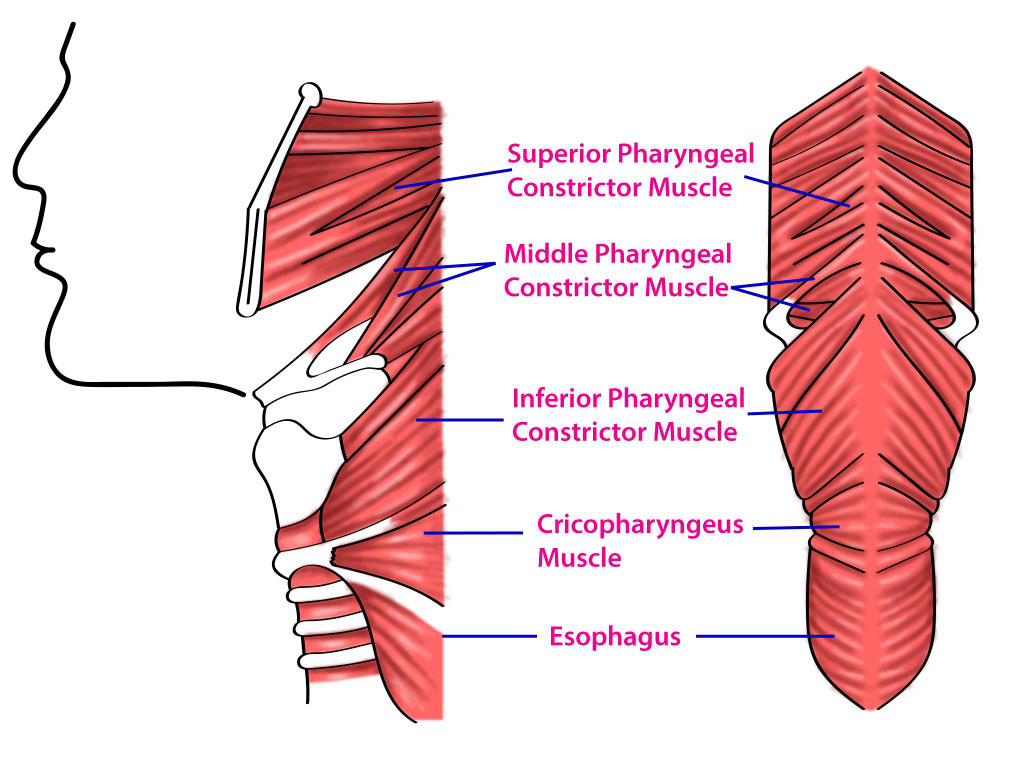[1]
Sakamoto Y. Gross anatomical observations of attachments of the middle pharyngeal constrictor. Clinical anatomy (New York, N.Y.). 2014 May:27(4):603-9. doi: 10.1002/ca.22344. Epub 2013 Dec 17
[PubMed PMID: 24343865]
[2]
Shaw SM, Martino R. The normal swallow: muscular and neurophysiological control. Otolaryngologic clinics of North America. 2013 Dec:46(6):937-56. doi: 10.1016/j.otc.2013.09.006. Epub 2013 Oct 23
[PubMed PMID: 24262952]
[3]
Choi DY, Bae JH, Youn KH, Kim HJ, Hu KS. Anatomical considerations of the longitudinal pharyngeal muscles in relation to their function on the internal surface of pharynx. Dysphagia. 2014 Dec:29(6):722-30. doi: 10.1007/s00455-014-9568-z. Epub 2014 Aug 21
[PubMed PMID: 25142243]
[4]
Adams A, Mankad K, Offiah C, Childs L. Branchial cleft anomalies: a pictorial review of embryological development and spectrum of imaging findings. Insights into imaging. 2016 Feb:7(1):69-76. doi: 10.1007/s13244-015-0454-5. Epub 2015 Dec 10
[PubMed PMID: 26661849]
[5]
Huang MH, Lee ST, Rajendran K. Clinical implications of the velopharyngeal blood supply: a fresh cadaveric study. Plastic and reconstructive surgery. 1998 Sep:102(3):655-67
[PubMed PMID: 9727428]
[6]
Hacein-Bey L, Daniels DL, Ulmer JL, Mark LP, Smith MM, Strottmann JM, Brown D, Meyer GA, Wackym PA. The ascending pharyngeal artery: branches, anastomoses, and clinical significance. AJNR. American journal of neuroradiology. 2002 Aug:23(7):1246-56
[PubMed PMID: 12169487]
[7]
Devadas D, Pillay M, Sukumaran TT. A cadaveric study on variations in branching pattern of external carotid artery. Anatomy & cell biology. 2018 Dec:51(4):225-231. doi: 10.5115/acb.2018.51.4.225. Epub 2018 Dec 29
[PubMed PMID: 30637155]
[8]
Lengelé B, Hamoir M, Scalliet P, Grégoire V. Anatomical bases for the radiological delineation of lymph node areas. Major collecting trunks, head and neck. Radiotherapy and oncology : journal of the European Society for Therapeutic Radiology and Oncology. 2007 Oct:85(1):146-55
[PubMed PMID: 17383038]
[9]
Tsumori N, Abe S, Agematsu H, Hashimoto M, Ide Y. Morphologic characteristics of the superior pharyngeal constrictor muscle in relation to the function during swallowing. Dysphagia. 2007 Apr:22(2):122-9
[PubMed PMID: 17318687]
[10]
Mu L, Sanders I. Neuromuscular compartments and fiber-type regionalization in the human inferior pharyngeal constrictor muscle. The Anatomical record. 2001 Dec 1:264(4):367-77
[PubMed PMID: 11745092]
[11]
Sakamoto Y. Interrelationships between the innervations from the laryngeal nerves and the pharyngeal plexus to the inferior pharyngeal constrictor. Surgical and radiologic anatomy : SRA. 2013 Oct:35(8):721-8. doi: 10.1007/s00276-013-1102-8. Epub 2013 Mar 21
[PubMed PMID: 23515953]
[12]
Uludag M, Aygun N, Isgor A. Innervation of the human cricopharyngeal muscle by the recurrent laryngeal nerve and external branch of the superior laryngeal nerve. Langenbeck's archives of surgery. 2017 Jun:402(4):683-690. doi: 10.1007/s00423-016-1376-5. Epub 2016 Feb 2
[PubMed PMID: 26843022]
[13]
Okuda S, Abe S, Kim HJ, Agematsu H, Mitarashi S, Tamatsu Y, Ide Y. Morphologic characteristics of palatopharyngeal muscle. Dysphagia. 2008 Sep:23(3):258-66. doi: 10.1007/s00455-007-9133-0. Epub 2008 Jun 21
[PubMed PMID: 18568287]
[14]
Murakami K, Kuroda M, Kishi K. [Variations of the constrictor pharyngeal muscles in humans]. Kaibogaku zasshi. Journal of anatomy. 1996 Dec:71(6):638-49
[PubMed PMID: 9038006]
[15]
Mesti JJ, Cahali MB. Evolution of swallowing in lateral pharyngoplasty with stylopharyngeal muscle preservation. Brazilian journal of otorhinolaryngology. 2012 Dec:78(6):51-5
[PubMed PMID: 23306568]
[16]
Clavé P, Shaker R. Dysphagia: current reality and scope of the problem. Nature reviews. Gastroenterology & hepatology. 2015 May:12(5):259-70. doi: 10.1038/nrgastro.2015.49. Epub 2015 Apr 7
[PubMed PMID: 25850008]
[17]
Stokely SL, Peladeau-Pigeon M, Leigh C, Molfenter SM, Steele CM. The Relationship Between Pharyngeal Constriction and Post-swallow Residue. Dysphagia. 2015 Jun:30(3):349-56. doi: 10.1007/s00455-015-9606-5. Epub 2015 Apr 29
[PubMed PMID: 25920993]
[18]
Khan A, Carmona R, Traube M. Dysphagia in the elderly. Clinics in geriatric medicine. 2014 Feb:30(1):43-53. doi: 10.1016/j.cger.2013.10.009. Epub
[PubMed PMID: 24267601]
[19]
Edwards BA, White DP. Control of the pharyngeal musculature during wakefulness and sleep: implications in normal controls and sleep apnea. Head & neck. 2011 Oct:33 Suppl 1(Suppl 1):S37-45. doi: 10.1002/hed.21841. Epub 2011 Sep 7
[PubMed PMID: 21901775]
[20]
Dewan K, Santa Maria C, Noel J. Cricopharyngeal Achalasia: Management and Associated Outcomes-A Scoping Review. Otolaryngology--head and neck surgery : official journal of American Academy of Otolaryngology-Head and Neck Surgery. 2020 Dec:163(6):1109-1113. doi: 10.1177/0194599820931470. Epub 2020 Jun 23
[PubMed PMID: 32571156]
Level 2 (mid-level) evidence
[21]
Berger MH, Weiland D, Tierney WS, Bryson PC, Weissbrod PA, Shah PV, Shah RN, Buckmire RA, Verma SP. Surgical management of recurrent Zenker's diverticulum: A multi-institutional cohort study. American journal of otolaryngology. 2021 Jan-Feb:42(1):102755. doi: 10.1016/j.amjoto.2020.102755. Epub 2020 Oct 17
[PubMed PMID: 33099230]

